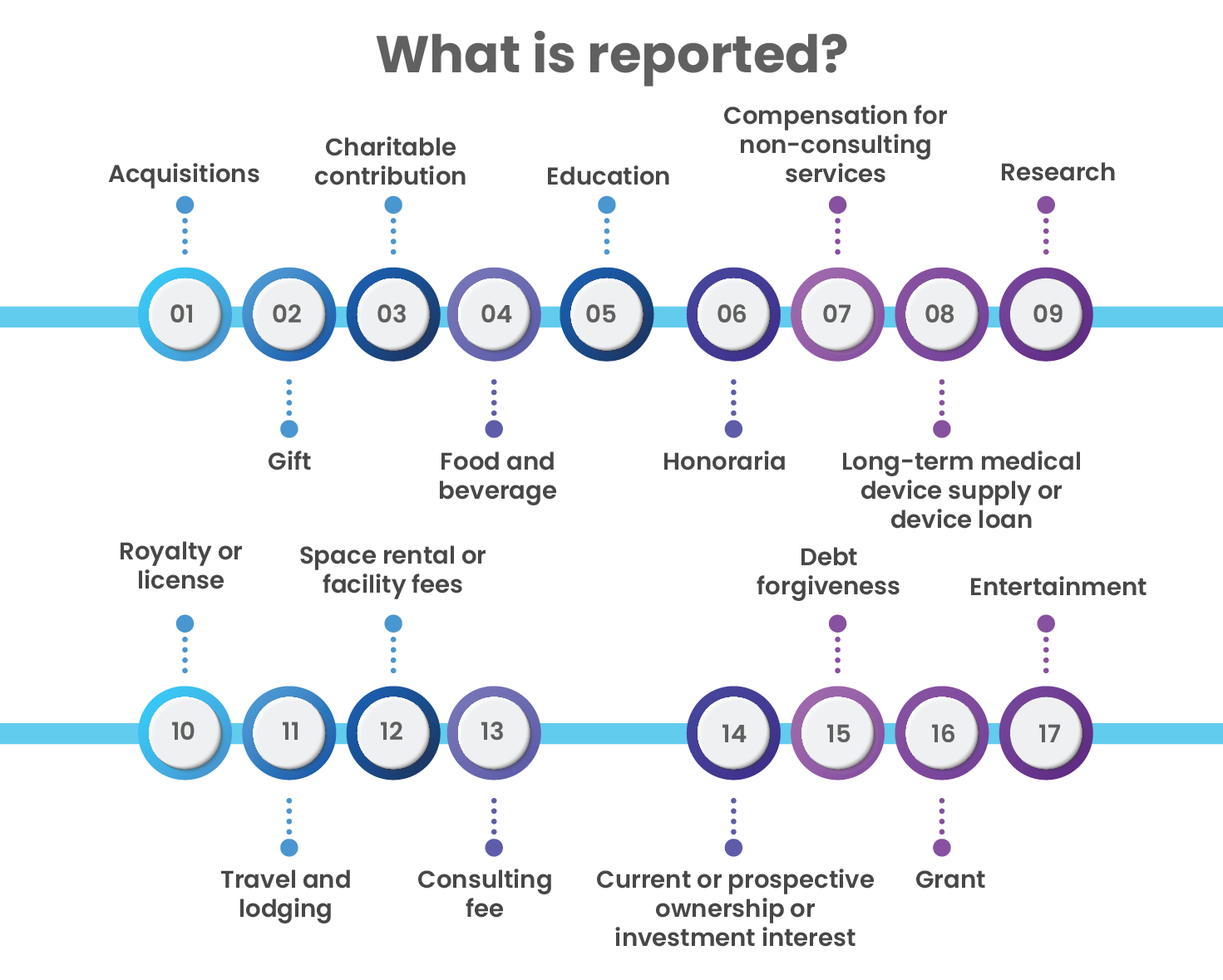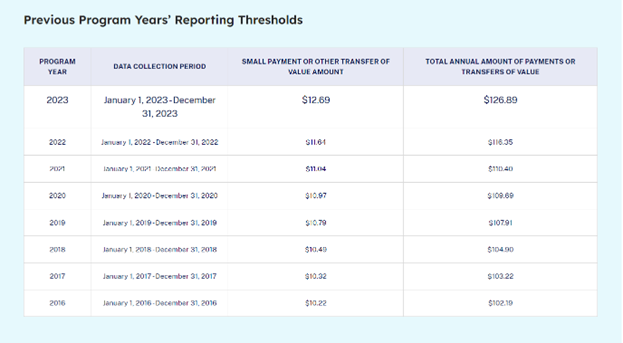The CMS Open Payments Program requires life sciences companies to report payments and transfers of value to physicians, teaching hospitals, and other covered recipients to the Centers for Medicare and Medicaid Services (CMS).
Out of the several critical aspects of this program, one is adhering to the de minimis rule for reporting spend data.
For each calendar year, if a payment or transfer of value is below a set minimum threshold, it is excluded from reporting requirements. Note that there are two thresholds for de minimis reporting requirements.
- Single TOV
- Annual TOV
If the total annual amount transferred to or designated on behalf of a covered recipient exceeds the established threshold, all such payments must be reported by the reporting entities.
These thresholds are adjusted annually based on the consumer price index (CPI), ensuring they reflect current economic conditions.
Let us understand the several types of thresholds, common issues faced by organizations, how thresholds impact your reporting, their application in the CMS Open Payments data, and more.
What are the Financial Thresholds in CMS Open Payments Reporting?
Financial thresholds in Open Payments Reporting determine which payments or transfers of value must be reported to the CMS.
These thresholds ensure that the transactions that meet certain criteria are disclosed to the CMS. Understanding these thresholds is essential for ensuring compliance with the reporting requirements enacted by the CMS.
Here are the several types of financial thresholds involved in CMS Open Payments reporting:
Different Types of Financial Thresholds
- Individual Payment Thresholds: Payments or transfers of value exceeding $13.07 in 2024 must be reported.
- Aggregate Payment Thresholds: If the total value of payments to a covered recipient exceeds $130.66 within a calendar year, reporting is applicable.
For more information, visit transparency reporting requirements.
Key Financial Thresholds for 2024
Changes and Updates from Previous Years
Financial thresholds and reporting requirements have changed since the program’s inception, reflecting the CMS’s efforts to balance transparency within the industry with practicality.
The above comparison of the reporting thresholds from 2016 to 2023 demonstrates a gradual increase year-over-year (YoY), highlighting the program’s responsiveness to economic conditions and the need for ongoing adjustments to maintain effective oversight.
Understanding these changes is critical for compliance officers, as thresholds are adjusted to account for inflation, policy shifts, changes in applicable rules and regulations, and more.
Reporting Challenges for Life Sciences Companies
Life sciences companies face various challenges in adhering to CMS Open Payments reporting thresholds. Ensuring accurate data collection and submission can be complex, especially with evolving regulations and multiple payment categories.
Additionally, analyzing expense data can help identify payments that exceed or fall below the thresholds, allowing compliance officers to decide if a transfer of value needs to be reported to CMS. This aspect has proven to be challenging over the years.
Common Issues Faced by Organizations
- Difficulty categorizing payments correctly
- Keeping track of multiple transactions across different departments
- Ensuring data accuracy and completeness
- Managing state-specific reporting requirements
- Understanding and applying exemption or inclusion criteria
- Adapting to changes in thresholds and reporting requirements
Strategies for Adhering to Reporting Thresholds
- Implement AI-powered Open Payments Reporting Solution to evaluate data
- Regularly train staff on reporting requirements and updates
- Automate data collection and validation to reduce human errors
- Establish clear internal policies for categorizing payments
- Conduct periodic audits to ensure data accuracy
- Stay informed on changes in thresholds and reporting requirements
What Is the Role of Compliance Officers in Managing Thresholds?
Compliance officers play an integral role in ensuring organizations adhere to CMS Open Payments thresholds. They help life sciences companies to submit complete and accurate Open Payments Reports to the CMS as per the regulatory authority’s reporting requirements.
Additionally, implementing systems and processes, aggregating data, conducting spend data audits, and ensuring timely reporting to CMS are just a few of the responsibilities that compliance officers undertake to ensure compliance with applicable rules and regulations.
Best Practices for Monitoring and Compliance
To effectively monitor financial thresholds, compliance officers should:
- Leverage AI-driven solutions to assure efficiency and effectiveness
- Develop clear policies and procedures for tracking payments
- Foster a culture of transparency and accountability
- Engage in continuous education and training on compliance requirements
Let us take a deeper look at how exactly compliance tools and technologies can help compliance officers adhere to regulatory demands.
Tools and Technologies for Adhering to CMS Financial Thresholds
1. Open Payments Reporting Solution
A purpose-built solution for CMS Open Payments Reporting empowers compliance teams to submit accurately and promptly CMS Federal and State spend reports.
By supporting various reporting processes such as identifying outliers and duplicate entries or validating HCP/HCO data – the solution streamlines the reporting process, assuring compliance with the financial thresholds required for CMS Open Payments Reporting.
2. AI-powered Expense Monitoring & Auditing Solution
AI enables compliance officers to conduct 100% audits of expense data within a few minutes. It integrates with data sources such as SAP Concur and other T&E systems to extract data efficiently, saving time, reducing errors, and enhancing efficiency.
3. AI (Artificial Intelligence) for Detecting Payments Exceeding Thresholds
AI systems can automatically flag payments that meet or exceed thresholds.
By integrating data from various sources, these tools identify outliers and policy violations, ensuring compliance with CMS reporting requirements.
The solution provides a streamlined process for managing and analyzing payments efficiently.
4. OCR & ML Technology
Optical Character Recognition (OCR) and Machine Learning (ML) technologies enhance compliance by converting physical documents into digital data and identifying irregularities.
These tools help verify expense data against compliance requirements, detect fraudulent activities, and ensure accurate reporting by automating data validation and analysis processes.
Future Trends and Considerations
Potential Changes in Regulations
As healthcare continues to evolve, we anticipate potential changes in CMS Open Payments regulations. These changes may include adjustments to thresholds, expanded definitions of covered recipients, and enhanced reporting requirements.
Similarly, financial thresholds may evolve to accommodate inflation, changes in industry practices, and regulatory updates. Staying informed about these changes will be crucial for compliance officers and life sciences companies.
Key Takeaways
- In 2024, CMS requires reporting of transfers of value, with thresholds adjusted annually based on CPI.
- Payments exceeding $13.07 and aggregated payments of over $130.66 are to be included in the Open Payments Reports.
- Companies face challenges such as categorization errors, data accuracy concerns, and adapting to changing thresholds and regulations.
- CMS Open Payments Reporting solutions can be used for data evaluation, collection, and process automation to meet CMS reporting standards.
- AI-powered solutions assist in monitoring expenses, detecting threshold violations, and ensuring compliance with CMS reporting requirements.
Other Relevant Reads:






